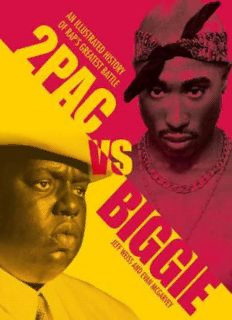
Life After Death PDF
Preview Life After Death
CONTENTS Preface Chapter 1 PORTRAITS OF THE ARTISTS AS YOUNG MEN Chapter 2 WHERE THEY CAME FROM, WHERE THEY WENT Chapter 3 AESTHETIC APPEARANCES & EXPERIENCES Chapter 4 RISE TO POWER Chapter 5 FEUDS AND MURDERS Chapter 6 DOUBLE ALBUMS: ALL EYEZ ON ME, LIFE AFTER DEATH Chapter 7 LEGACY Bibliography Acknowledgments Index Less than two decades after the deaths of Tupac Shakur and Christopher Wallace, it has become impossible to speak one name without hearing the other. 2Pac and Biggie. Biggie and 2Pac. You see a poster of one and think of an image of the other. You get to know a friend, a fellow rap fan, and you ask whom they prefer. It feels natural when a party’s soundtrack moves from the fizzy, delirious “California Love” to the elemental bass of “Hypnotize.” Biggie and 2Pac. 2Pac and Biggie. They died six months apart. Tupac was murdered in September of 1996, Biggie in March of 1997. Since then, their complicated bond has ossified in our social memory. The ampersand, the ellipsis, the “vs.”—whatever link now appears in our mind when we think about 2Pac and Biggie is due for complication. This book is an attempt to provide listeners, new and old, with fresh angles for appreciating The Notorious B.I.G. and 2Pac. (Throughout the book, “Tupac” will refer to the person, “2Pac”—his rap name—to the artist.) They were dynamic men, driven self-inventors and iconoclasts. Born a chubby, doted-upon only child, Biggie became a dapper hip-hop don with a visceral, visual imagination and a voice like cavalry riding across marble. 2Pac was a reedy art-school student who transformed himself into the most famous poet-provocateur-outlaw this side of Rimbaud. Both served as the faces of industry- shaking record labels. Both ushered rap into the era of pyrotechnic music videos, pop dominance, and global audiences. But why Biggie and 2Pac? While subversive, neither rapper made the most transgressive songs of the era. Each had massive commercial success, but neither cut a particularly pop-friendly figure. However, as different as they were in appearance, biography, and temperament, they shared one magnificent quality: the ability to synthesize an assortment of artistic virtues into a singular, irresistible presentation. Where Biggie became a master of genre and perspective and detail, 2Pac created rhetoric that could champion sprawling spirituality and triumphant cooperation in one moment and fierce self- preservation and fatalism in the next. They did not merely emphasize their strengths as MCs and rappers and performers; they each created a verbal universe. For this kind of artistic fulfillment to happen once in a generation is an event. For it to happen to two artists, and for the artists not only to know one another but also to find their work in dialogue and their lives woven together with threads of camaraderie, betrayal, and death, is monumental. The books about the two are many. In particular, the time from Tupac’s criminal trial in 1994 until Biggie’s murder in 1997 has been examined, researched, and argued endlessly. But this book aims to bring fresh perspective to the irreducible core of 2Pac and Biggie’s shared legacy: the music. After all, music—seminal albums, unforgettable singles, and apocryphal early recordings—is what they have left behind. We examine Biggie and 2Pac individually, talk about each stage in their lives and how each rendered that chapter or theme into music. Their subjects were the timeless subjects of American pop music: childhood, adolescence, love, sex, getting rich, staying rich, family, friendship, hate, work, play, choice, fate. And the lyrical routes each took across this terrain reflect their identities as artists. The instances of consonance thrill: a creeping paranoia infuses both 2Pac’s “All Eyez On Me” and Biggie’s “My Downfall.” The instances of separation instruct. Compare the two approaches to biography in 2Pac’s sympathetic, humane “Dear Mama” and in Biggie’s clinical, systematic “Sky’s The Limit.” Their lyrical approaches, song structures, storytelling habits, vocabularies, cadences, engagements with big human themes—these are what make Biggie and 2Pac so endlessly fascinating, so rewarding to hear individually and in contrast. We are fascinated by Biggie and 2Pac because the cultural moment in which we live is part of their legacy. Hip-hop has become pop. The art of rap has influenced singers, songwriters, and producers in every genre of popular music. A hundred would-be rappers use manufactured “beef” to try to drum up record sales. The line between performer and performance was always permeable and useful, but Biggie and 2Pac made it threatening. Academia has taken up both men as subjects of study. 2Pac’s face appears on murals in ghettos, favelas, and shantytowns around the world. Biggie’s phrases nestle in sitcom scripts and news teleprompters. A decade after Biggie documented the bloodless exchange of human dreams for crude capital in his album Life After Death, we lived through a financial meltdown that felt very much like one of his unflinching narratives. A decade after we heard 2Pac rap, “We ain’t ready to see a black president,” we elected one. We can’t separate them. We shouldn’t. They move like neighboring constellations across an American night sky. We may momentarily lose sight of one as we gaze at the other, but we cannot appreciate them alone. The poet and the orator. The line and the circle. The Atlantic and the Pacific. 2Pac and Biggie. Biggie and 2Pac.
Description: